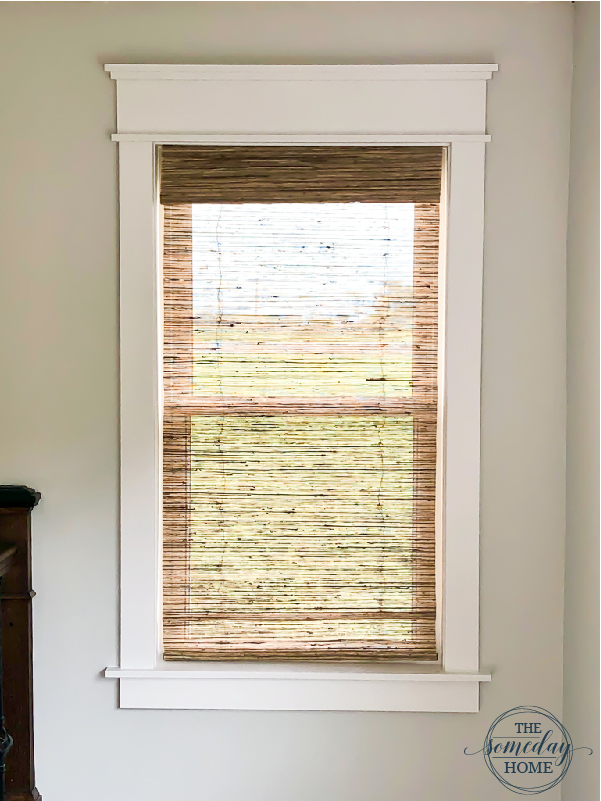Sometimes the simplest projects have the biggest impact- and that’s exactly the case with this project. Our super simple DIY farmhouse window trim completely elevated the look of the entire room. In fact, outside of my DIY fireplace and my new rug, our window trim is something that inevitably gets mentioned when people are in our home (and no, I’m not always the one who brings it up… although, admittedly, I am a little bit obsessed). If you’re looking for a simple, affordable way to add some character to your home, this DIY farmhouse window trim project is for you!
In its original state, our living room was sporting the dreaded orange-y maple trim around the windows and the floors. I could have painted it white and called it a day, but I had my heart set on something with a little more character.

Also, when we had our windows replaced, we also ended up replacing all of the drywall on those walls. I couldn’t see myself re-installing orange trim that I didn’t love over our brand new drywall, so our living room sat without any window trim at all for a while.
This was one of those projects I put off doing for a while because I thought it was going to be hard to figure out in terms of materials, cuts, and measurements. That couldn’t have been farther from the truth! If you’re on the fence about giving this project a try, don’t wait on it like I did :).
DIY Farmhouse Window Trim
Materials:
1 x 6 Primed MDF board
1 x 4 Primed MDF board
1 x 2 Primed MDF board
2” brad nails
Paintable caulk (if you’re painting your trim- if your trim will be stained, I would recommend using a clear caulk)
Tools:
Table Saw
Miter Saw
Brad Nailer
We installed all of this with 2” brad nails, with the exception of the head jambs, where we opted to use screws.
Window Jambs and Stools
Before we could start on the trim, we had to do our jambs and stools. This next picture isn’t a pretty one, but it is the best one I have to illustrate jambs and stools.

If you’re just replacing your window trim, you might not have to do this part. However, if your window stool isn’t as bulky as you want it to be, you may have to replace it. I wanted ours to extend out past our trim by about an inch (give or take), so we knew our stool needed to be wider than our head and side jambs.
We used 1 x 4 select pine boards to line the interior part of the window (the side jambs and the head jamb). To make our stool, we used a 1 x 6 with the ends notched out (to slide in between the side jambs).
Building Simple DIY Farmhouse Window Trim
For quick reference, here’s a picture with all of our boards labeled.

Side trim
Once we had our jambs and our stool in place, we were ready to build our trim. We started with our sides. We attached our 1 x 4 primed MDF boards to the sides, running them from the very top of the stool up the whole length of the window plus 1/8” for a slight jamb reveal. This part is important- and I never gave it much thought before. Pay attention the next time you look at professionally installed window or door trim- there is always a small area of the jamb that isn’t covered by the face trim. Why the 1/8” reveal? No board is perfect, and if you try to line up the side trim with the side jamb to make it completely flush, you’ll notice any curve or warp in the board, not to mention that even if it does flush up perfectly at the time of installation, changes in humidity or your house settling can cause even the most perfectly straight boards to warp and curve. A 1/8-3/8” reveal not only helps disguise those imperfections, it also elevates the overall look of your trim job.

I also want to mention here to measure EVERY side of your window before you cut. Just because the left side of your window trim needs to be cut to 56 3/16” does NOT mean your right side will also. Differences in how your stool and top jamb are sitting can mean different lengths on each side. For all of my perfectionists out there (… sheepishly raises own hand…), this might drive you a little batty, but just know that your walls are probably not perfectly… perfect. Tailoring each piece of trim to the actual size of your window will ensure that everything fits together well and looks perfect. Even if your walls aren’t. (It’ll be a dirty little secret between you and your walls… I promise, I won’t tell anyone).
Apron
Under the stool, we ran a 1 x 4 to span the width of the window + the side trim. Although they’re separated by the stool, we wanted the ends of the apron to line up as perfectly with the sides of the trim as we possibly could.
Head Trim

This bulky top trim makes my heart so. happy. I love it, but I do have to admit that it was the most obnoxious part of the process. I specifically wanted my 1 x 2s to have a subtle difference in width from my side trim, so using the 1 x 2 in its original form wasn’t going to work- it was going to stick out too far. We fired up the table saw and shaved off 1/4” to make them 1 ¼ wide (because, y’know… if it’s not confusing enough already, we should mention that when a board says it’s 1 x 2, that actually means it’s ¾ x 1 ½). This meant that it was going to protrude from my side trim by 1/2” which was the perfect subtle difference I was looking for.
To keep things consistent, we also opted to bring the 1 x 2s (which- remember- were no longer 1 x 2’s, or more appropriately, ¾ x 1 ½s, they were now ¾ x 1 1/4s) ½” past our side trim on each side.
On top of our ripped-down 1 x 2s (¾ x 1 ¼s), we put our 1 x 6 board. We spanned the width of the window plus the two side trim pieces, to keep it clean. Then we added another ripped-down 1 x 2, cut to the same length as the bottom one (width of the window + two side trim pieces + 1” {remember, we did the ½” extra for each side}).
We needed one more piece for the top, and I wanted to stay consistent with my 1/2” extra protrusion all around, which meant I needed a board to be 1 ¾” wide… of course, ¼” too wide to be a regular 1 x 2. We ended up ripping down a 1 x 4 to the appropriate width (1 ¾” wide), and again, extended it ½” past the top piece it was sitting on. This allowed our very top trim to line up perfectly with our stool- something that makes my husband’s OCD brain very happy.
Finishing
Once all of the pieces were installed, I caulked all of the joints and any gaps we had between the walls and the trim, or the jambs and the windows. I also used wood filler to hide the nail holes from the brad nailer.
A quick note
One thing I did that I totally regretted was painting my trim pieces before we installed them. I thought it would be easier to paint them on the floor rather than having to paint them when they were up on the wall (having to tape, pull out the ladder, etc.). After caulking and filling nail holes, I had to touch up the paint anyway. Painting before installing was an extra step that was unnecessary.
I’m still working on eradicating the orange wood from our home, but I’m proud to say that there is no more orange in my living room! I can’t wait to share it with you when it’s finished!



2 Replies to “DIY Farmhouse Window Trim”
Can you put a wider board vs the 1×6 on the bottom for a window sil for plants? How much larger can you make it, or how do you support a wider sill.
Hi Ingrid! You probably could- I don’t know if I would make it much wider without adding some sort of support though. Perhaps some cute corbels or even shelf supports.
Comments are closed.